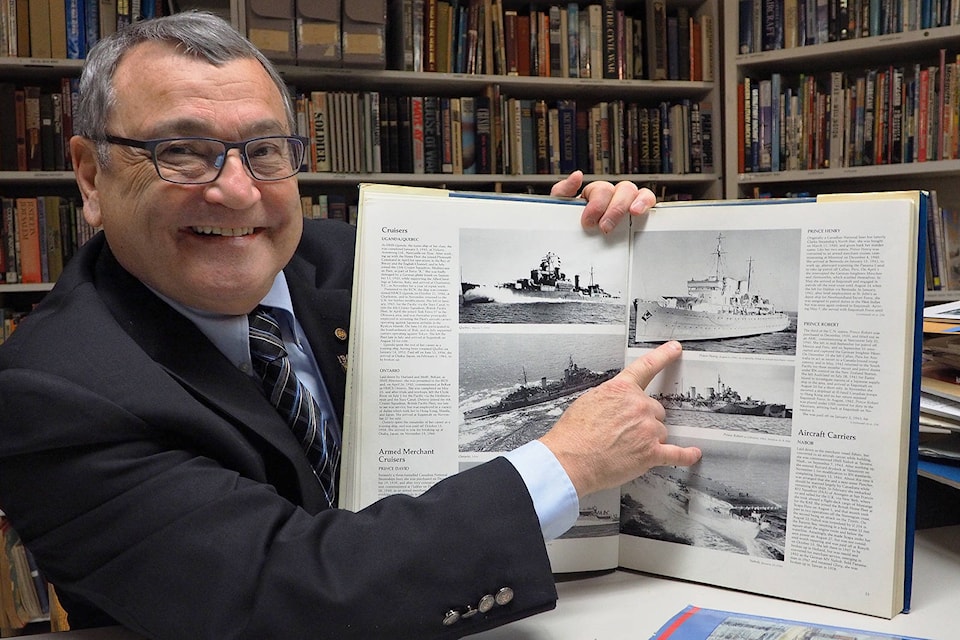A cruise ship that once carried vacationers on B.C.’s coast earned its place in history when it landed Vancouver Island’s infantry regiment on the beaches of Normandy.
The SS Prince Henry, built in England, started in 1930 with the the Canadian National Steamship Lines as a mid-size luxury liner.
The Great Depression of the 1930s was a difficult time for luxury cruises and after failing to turn a profit on the B.C. coast, the vessel was sold to the Clarke Steamship Company in Montreal and renamed the SS North Star.
“This ship was fascinating because it plies these waters, not economically because it failed miserably, and then it was sold off to another company that tried to make a go of it,” said Greg Devenish, Vancouver Island Military Museum librarian, who wrote an article about the ship
for the museum’s spring 2019 edition of its newsletter Dispatches, which commemorates the 75th anniversary of D-Day.
SS Prince Henry had an inauspicious start as a merchant vessel, in spite of it being a state-of-the-art cruise ship for its time, but its fortunes changed and it would earn its place in western maritime history when the Royal Canadian Navy purchased it and its sister ships, Prince Robert and Prince David and changed the SS North Star’s name to HMCS Prince Henry.
“It was a really nice cruise ship,” said Devenish, whose uncle served aboard HMCS Prince David. “I mean, for that size of ship, it had the bells and whistles for its time … it was doing cruises to Alaska and then operating here on the coast and then, as the federal government did in Word War I, they seconded civilian ships to fill the gap and turned it into an armed cruiser. They took parts off of World War I ships.”
Following the conversion, HMCS Prince Henry patrolled the Pacific off the coast of Peru and was involved in sinking two German merchant ships, Hermonthis and Muenschen before it was ordered back to Esquimalt.
After Canada declared war against Japan, HMCS Prince Henry escorted ship convoys between Kodiak and Dutch Harbor, Alaska.
In 1943, HMCS Prince Henry and Prince David were converted to landing ships and rearmed at Burrard Dry Dock in Vancouver in preparation for the invasion of Normandy.
The re-fit bolstered the ships’ war-fighting capabilities and HMCS Prince Henry arrived in England ready to go into a fight, with eight landing craft and weaponry, to defend against enemy aircraft and target onshore German defence installations.
On June 6, 1944, HMCS Prince Henry joined the largest invasion force in military history and delivered 147 members of the Canadian Scottish Regiment, based on Vancouver Island, plus troops from the 7th Canadian Infantry Brigade to Juno Beach.
RELATED: D-Day veterans revisit Normandy, recall horror and triumph
RELATED: 75 years later, legacy of Canada’s role in D-Day landing recalled
In July 1944, HMCS Prince Henry was chosen the flagship for U.S. Navy Rear-Admiral Theodore Chandler for Operation Dragoon, the invasion of southern France that was carried out in August.
“It was turned into a hospital ship, as well and it landed, strangely enough, members of the American-Canadian [1st Special Service Force] … and they landed troops there too,” Devenish said.
The ship went on to carry out operations in Greece until the end of the war when it was sold off to the British Royal Navy.
The ship’s last operation was to land troops during the Suez Crisis of 1956. It was decommissioned in 1962.
“This ship, from ’31 to ’61 had quite a career … it’s a great story,” Devenish said.
photos@nanaimobulletin.com
Like us on Facebook and follow us on Twitter
